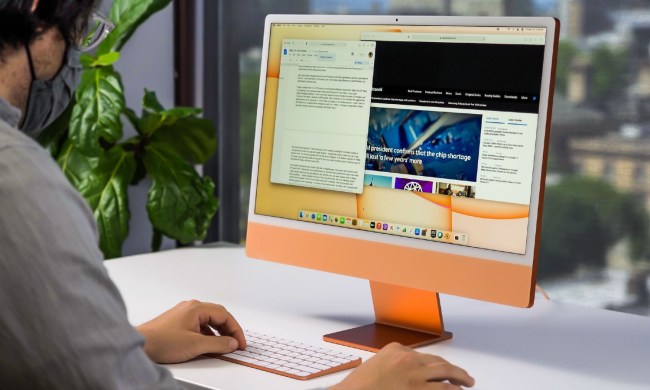iMac, Mac Mini, MacBook Pro, or MacBook Air — there are a lot of different Macs to choose from. On the desktop front, though, the two obvious choices are the Mac Mini and the new 24-inch iMac (2021).
In this guide, we put up the specs on the newest, refreshed Mac Mini against the iMac. We probably would have never compared these two in the past, but since both are now running Apple’s M1 chip, they offer very similar core experiences. Which one is best will depend on what type of user you are, hence the need to compare them. Weighing in features like design, performance, and our overall impressions of the new Mac Mini, we’ll help you decide which is right for your setup at work or home.
If you’re in the market for a new machine, take a look at the best iMac deals and the best Mac Mini sales available now. After all, Apple devices rarely come cheap.
Design

Both the iMac and Mac Mini are made of aluminum and are designed as desktops, but the form factor could not be more different between the two. At 2.6 pounds and 1.4 inches in thickness, the Mac Mini is a thin slab of metal that is similar to a super-compact cable box.
A highlight for us in our review, the Mac Mini is ideal for sitting under a monitor or at the side of a desk. It easily stays out of the way in places with limited space and the fans are quiet as a whisper. Great as that is, the sleek space gray aluminum design doesn’t account for monitors or keyboards, all of which need to be purchased separately, reflecting its history as a computer designed for Windows switchers who likely already had these accessories.
The iMac is very distinguishable from the Mac Mini. Whereas the new M1 Mac Mini looks exactly like the model before it, the new iMac has been completely redesigned. For one, the whole package is incredibly thin, with the display housing being a mere 11.5 millimeters (about 0.45 inches) thick. That’s remarkable, especially considering the bulky and largely unchanged housings of prior iMac models.
It stands at 18.1 inches tall and 21.5 wide, making it slightly bigger overall than the previous 21.5-inch model. The compact housing holds a single speaker, which performs admirably for the size, but you will want something bigger and better.

However, thanks to the thin design, it certainly doesn’t feel bigger. Plus, that marginal size increase comes with a notably bigger 24-inch 4.5K Retina display, up from the
The iMac also includes six high-fidelity speakers that support
The iMac is more vibrant than ever with Apple’s new color choices. Before, Apple’s desktops only came in silver (or space grey if you opted for an iMac Pro). However, the company has embraced a more vibrant design language, and that comes through in the new iMacs. The base model (more on the distinctions and prices below) comes in four colors: blue, green, pink, and silver. The other (more expensive) model adds yellow, orange, and purple to those choices.

The iMac still comes with a Magic Keyboard, except now the keyboards also come in the colors listed above. Apple has also revamped the keyboards with new shortcuts (including a dedicated Spotlight key). The more premium keyboard even comes with TouchID built-in.
The iMac is undoubtedly appealing to long-time Apple fans, especially if they wanted something a bit more expressive. The iMac has always been a great all-in-one-computer, and the latest iteration will likely maintain its positioning as the best.
That doesn’t mean it’s for everyone, though. The M1 Mac Mini is ideal for people who have a lot of peripherals already or prefer more control over the look and functionality of their setup. It’s also half the cost of the new iMac.
Performance

Even without the included peripherals of the iMac, the Mac Mini is a compelling purchase — especially if performance is a crucial factor. The Mac Mini houses the same M1 chip found in the MacBook Air, MacBook Pro, and the upcoming iMac. It also begins with 8GB of unified memory, which can be upgraded to 16GB. The base model also has options for a 256GB SSD all the way to a 2TB option.
In terms of performance, the Mac Mini is an absolute beast and was the best performer of the original M1 lineup.
The new iMac will launch with the same 8-core M1 chip found in the Mac Mini, and it can also be configured with up to 16GB of unified memory. However, its storage caps out at 1TB, half the amount of the Mac Mini. If you purchase the upgrade model, you can still get the 2TB storage option. Because of the graphics power of the M1 chip, the new iMac does not include an option for dedicated graphics.
There is one distinction, though. The M1 Mac Mini has the full 8-core GPU, whereas the base iMac only has a 7-core GPU in the M1 chip. That means the M1 Mac Mini will perform better for games and graphics-intensive tasks like video rendering. However, the upgraded iMac model includes the full 8-core GPU, so factor that into your purchasing decision.
There is no real reason to think there will be a considerable difference between the two in terms of performance. Both will perform better than the laptop variants, but it is hard to imagine one having significantly better performance over the other. Your purchasing decision between the two will likely come down to what peripherals you already have, your budget, and the connectivity (which we cover in the next section).
Connectivity">Connectivity

There is a world of difference in the I/O between the Mac Mini and the iMac. Let’s break it down.
The Mac Mini had a notable downgrade in connectivity from the last generation, but even then, it is far more robust than the forthcoming iMac. The Mac Mini has two Thunderbolt/USB 4 ports, two USB-A ports, an HDMI port, a 3.5mm headphone jack, and a Gigabyte Ethernet port.
Compare that to the two
If you want robust I/O from either of them, you will have to get USB-C dock or hub. However, the M1 Mac Mini has a slight leg up over the iMac.
The Mac Mini is the best deal (unless …)

For most people, the Mac Mini is going to be the best option. In all likelihood, you already have many of the peripherals needed to get it going or can get them for a reasonable price. Even if you’re coming from an iMac, you already own a Magic Keyboard and a Magic Trackpad or Magic Mouse. At $699, the Mac Mini delivers functionally the same performance at almost half the price.
However, if this is a first computer (either for you or someone you know), then the iMac is still a good option. When you consider the cost of buying a keyboard, a computer, and a high-quality
What about the $1,499 option? Well, that depends. The big differences between the upgraded model and the base one are the larger storage option, the additional GPU core, and two additional ports. In our opinion, it’s not worth it. You will likely need to buy a dock anyway, so the two additional ports become moot at that point. Unless you are a video professional, the additional GPU core likely won’t benefit you much, and you’re probably waiting for a “Pro” variant of the desktop lineup anyway if that’s your niche.
The Mac Mini is the best solution for most people, and the base model iMac is an excellent comprehensive option for new users.



